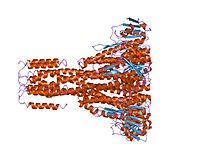The CorA transport system is the primary Mg2+ influx system of Salmonella typhimurium and Escherichia coli.[2][3] CorA is ubiquitous in the Bacteria and Archaea. There are also eukaryotic members of the family localized to the mitochondrial membrane such as MRS2 and Lpe10 in yeast.
| CorA-like Mg2+ transporter protein | |||||||||||
|---|---|---|---|---|---|---|---|---|---|---|---|
 Structure of the CorA Mg2+ transporter.[1] | |||||||||||
| Identifiers | |||||||||||
| Symbol | CorA | ||||||||||
| Pfam | PF01544 | ||||||||||
| InterPro | IPR002523 | ||||||||||
| TCDB | 1.A.35 | ||||||||||
| OPM superfamily | 66 | ||||||||||
| OPM protein | 2bbj | ||||||||||
| CDD | cd11744 | ||||||||||
| |||||||||||
Subfamilies
editHuman proteins containing this domain
editReferences
edit- ^ Lunin VV, Dobrovetsky E, Khutoreskaya G, et al. (April 2006). "Crystal structure of the CorA Mg2+ transporter". Nature. 440 (7085): 833–7. Bibcode:2006Natur.440..833L. doi:10.1038/nature04642. PMC 3836678. PMID 16598263.
- ^ Maguire ME, Kehres DG, Lawyer CH (1998). "The CorA magnesium transporter gene family". Microb. Comp. Genom. 3 (3): 151–169. doi:10.1089/omi.1.1998.3.151. PMID 9775386.
- ^ Smith RL, Maguire ME, Szegedy MA, Kucharski LM, Walker C, Wiet RM, Redpath A, Kaczmarek MT (1998). "The CorA Mg2+ transport protein of Salmonella typhimurium. Mutagenesis of conserved residues in the third membrane domain identifies a Mg2+ pore". J. Biol. Chem. 273 (44): 28663–28669. doi:10.1074/jbc.273.44.28663. PMID 9786860.
Further reading
edit- Kehres DG, Lawyer CH, Maguire ME (1998). "The CorA magnesium transporter gene family". Microb. Comp. Genom. 3 (3): 151–69. doi:10.1089/omi.1.1998.3.151. PMID 9775386.
- Smith RL, Szegedy MA, Kucharski LM, et al. (October 1998). "The CorA Mg2+ transport protein of Salmonella typhimurium. Mutagenesis of conserved residues in the third membrane domain identifies a Mg2+ pore". J. Biol. Chem. 273 (44): 28663–9. doi:10.1074/jbc.273.44.28663. PMID 9786860.
- Wiesenberger G, Waldherr M, Schweyen RJ (April 1992). "The nuclear gene MRS2 is essential for the excision of group II introns from yeast mitochondrial transcripts in vivo". J. Biol. Chem. 267 (10): 6963–9. doi:10.1016/S0021-9258(19)50522-1. PMID 1551905.